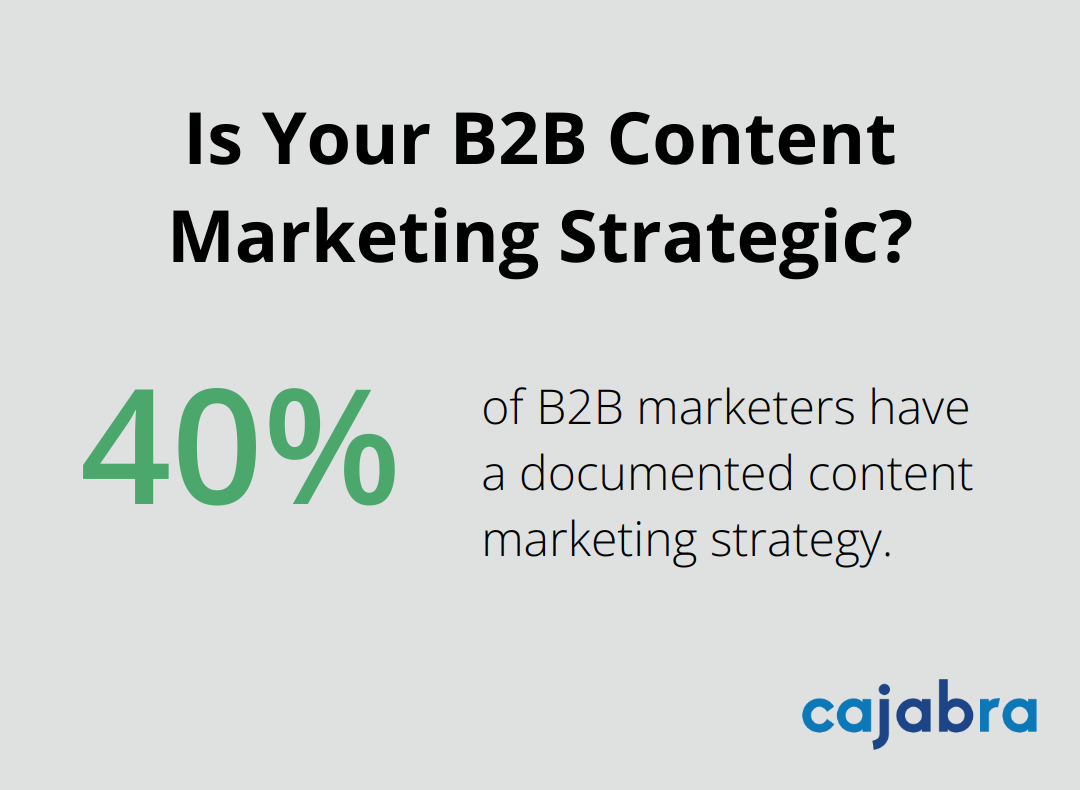
At Cajabra, LLC, we know that managing content effectively is key to business success. A well-structured content management strategy framework can transform your digital presence and boost your bottom line.
In this post, we'll guide you through the process of developing a robust framework that aligns with your business goals. Get ready to streamline your content operations and maximize your content's impact.
Content marketing is critical to improving SEO (Search Engine Optimization), which helps businesses become more visible and discoverable online. It's a comprehensive plan that guides the creation, organization, and distribution of content. This strategy aligns every piece of content with business objectives and audience needs, ensuring maximum impact and efficiency.
An effective content management framework consists of several essential elements:
The implementation of a robust content management strategy yields significant benefits. 40% of B2B marketers have a documented content marketing strategy. While most B2B marketers use content marketing, less than half have a documented strategy. This translates to increased website traffic, higher engagement rates, and ultimately, more conversions.
A well-structured strategy streamlines content operations, eliminates redundancies, and improves team collaboration. This efficiency often leads to substantial cost savings and improved ROI on content investments.
One of the most valuable outcomes of a solid content management strategy is its impact on customer experience. The right strategy ensures that appropriate content reaches the intended audience at the optimal time, significantly enhancing customer satisfaction and loyalty. Moreover, it maintains brand communication consistency across all channels, which is essential for building trust and recognition in today's fragmented digital landscape.

As we move forward, we'll explore the practical steps to develop your own content management strategy framework. This process begins with a thorough content audit and gap analysis, which will provide the foundation for your strategy.
A thorough content audit forms the foundation of an effective strategy. This process involves cataloging all existing content, including blog posts, social media content, and videos. Analyze each piece for relevance, performance, and alignment with current goals. This audit will reveal content gaps and improvement opportunities.

Tools like Screaming Frog can streamline the audit process. It crawls websites and provides detailed information about each page (including metadata, word count, and internal linking structure).
Your content strategy requires specific, quantifiable goals. Instead of vague aims, set concrete targets. For example:
Use the SMART criteria (Specific, Measurable, Achievable, Relevant, Time-bound) to refine your objectives. This approach ensures your goals remain concrete and actionable.
Develop in-depth profiles of your ideal customers. Go beyond basic demographics and explore their pain points, motivations, and content preferences. Use tools like Google Analytics to gather data on your current audience. Conduct surveys or interviews with existing customers to gain deeper insights.
Buyer personas represent your customer base and help you understand your audience better. They provide valuable insights into your customers' needs and preferences, allowing you to create more targeted and effective content.
Implement clear guidelines for content creation, approval, and distribution. This system should provide structure, establish clear roles and responsibilities, create detailed processes and workflows, and outline company standards and policies.
Project management tools like Asana or Trello can help track content tasks and workflows. These platforms allow you to create templates for different content types, ensuring process consistency.
Choose a CMS that aligns with your specific needs. Consider factors such as ease of use, scalability, and integration capabilities with your existing tools. Popular options include WordPress for flexibility, Drupal for complex, large-scale sites, or HubSpot for its all-in-one marketing capabilities.
The right CMS can significantly streamline content operations and improve team collaboration. When evaluating CMS options, prioritize those that offer robust content organization features, version control, and user-friendly interfaces for both content creators and developers.
As you implement these steps, you'll create a solid foundation for your content management strategy. The next crucial phase involves putting your strategy into action and optimizing it for maximum impact.
Start by educating your team on the new framework. Create comprehensive training materials that cover every aspect of your strategy. Include practical exercises and real-world scenarios to help team members apply the new concepts. A study by the Content Marketing Institute reveals that 73% of organizations with successful content marketing strategies provide their teams with ongoing content marketing training.

Try to implement a mentorship program where experienced team members guide newer ones. This approach can reduce the learning curve and foster a culture of continuous improvement.
Identify and track the right metrics to assess the effectiveness of your content strategy. Focus on metrics that directly align with your business goals. For instance, if your aim is to increase brand awareness, track metrics like social media engagement rates and website traffic.
Use tools like Google Analytics to monitor key performance indicators (KPIs) such as bounce rate, time on page, and conversion rates. HubSpot reports that companies that calculate ROI are 1.6 times more likely to receive higher budgets for their content marketing.
The digital landscape constantly evolves, and your content strategy should evolve with it. Review your strategy's performance against your set goals regularly. Make data-driven adjustments to improve results.
Conduct quarterly strategy reviews to assess what works and what doesn't. Use these insights to refine your approach. For example, if you notice that video content outperforms written articles, consider allocating more resources to video production.
Incorporate AI and automation tools to enhance your content strategy implementation. These technologies can streamline processes, improve content personalization, and provide valuable insights.
AI-powered tools can improve content quality by supporting your marketing strategies and boosting productivity. Content scheduling platforms can help you plan and schedule your content in advance, which is a huge time-saver and helps keep your social media consistent.
For content ideation, tools like BuzzSumo can analyze trending topics in your industry, helping you create timely and relevant content. According to Salesforce, 51% of marketers already use AI, with another 27% planning to incorporate it in the near future.
Implement a system to monitor your content strategy's performance continuously. Set up regular check-ins to review metrics and gather feedback from your team and audience. This proactive approach allows you to identify issues early and make necessary adjustments.
Try to create a culture of experimentation within your team. Encourage them to test new content formats, distribution channels, or messaging approaches. These experiments can lead to valuable insights and improvements in your overall strategy.
A content management strategy framework transforms businesses through careful planning and execution. This approach aligns content efforts with business goals and audience needs, leading to improved operational efficiency and enhanced customer experiences. At Cajabra, we've observed how a solid content strategy can revolutionize businesses, especially in the accounting industry.

The development of a content management strategy framework requires adaptability in today's fast-paced digital landscape. Your framework should evolve with changing market trends and audience preferences. Regular reviews and adjustments based on performance metrics and feedback will ensure its ongoing effectiveness.
You should start implementing your content management strategy framework today. The sooner you begin, the faster you'll see results. Take the first step by conducting a content audit or defining your content goals (these actions will kickstart your journey towards a powerful framework that drives your content efforts and propels your business forward).



